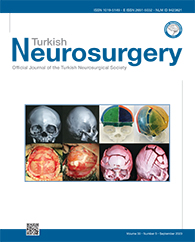2Southern Medical University, The First Clinical Medicine College, China
3Southern Medical University, Neural Networks Surgery Team, China
4Southern Medical University, Zhujiang Hospital, Department of Neurosurgery, China DOI : 10.5137/1019-5149.JTN.34207-21.2 AIM: To determine the feasibility and efficacy of aura intervention in preventing the recurrence of temporal lobe epilepsy (TLE) by observing the changes in the seizure frequency and quality of life (QOL) scale score.
MATERIAL and METHODS: A total of 160 patients will be selected from a pre-established database and randomly divided into the experimental group and the control group. The proposed study is divided into four stages and requires approximately one and a half years for completion. The primary outcome measure is the change in seizure frequency, and the secondary one is the quality of life.
RESULTS: We expect that our subjects show a lasting, stable, and clinically relevant reduction in seizure frequency and improvement in the quality of life, suggesting that aura intervention may be one more feasible way to treat patients with auras, specifically those who experience refractory epilepsy.
CONCLUSION: The ability to perceive auras is the premise of our trial. We mainly study TLE as it relatively has more incidence of auras and a higher cure possibility compared to other types of epilepsy. Although we currently address our problems in a small group of subjects, we believe that the studied aura intervention can easily be applied to millions of patients with epilepsy worldwide if this intervention is considered effective.
Keywords : Temporal lobe epilepsy, Seizure, Aura, Intervention




